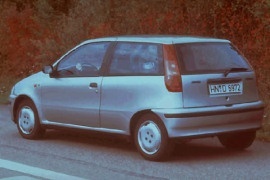
FIAT Punto 3 Doors
Generations Timeline, Specs and Pictures

In September 2011, Fiat introduced the 2012 Punto, a facelifted version of the previous Punto Evo, the car that brought the name back to life.
The main differences between the new model and its predecessors were the new trim levels, a couple of new technologies on board (like the start/stop function) and lower CO2 emissions, thanks to smaller engines like the 0.9-liter TwinAir turbocharged petrol unit. The design showed little improvement, mostly around the front bumpers alongside some new alloy wheels. The cabin also received some new accessories like new fabrics but also a new infotainment system.

The Italian car company introduced the second generation of the little Punto in 1999, and it enhanced it with an ample facelift in 2003.
Sometimes, the differences between a facelifted and the non-facelifted version of the same car are so subtle that you’d have to be an expert to see them. It wasn’t the same situation with the refreshed version of the second Punto generation, where the car was upgraded both outside and inside.
Fiat installed a completely new front fascia for the refreshed Punto lineup, with bigger headlights that were extended over the hood, and swept on the sides. The engineers asked for a grille above the bumper to increase the cooling factor. On the lower side of the bumper, a pair of side-scoops were integrated, with the fog-lights inside. The taillights were redesigned and extended over the tailgate, increasing the car’s visibility from behind.
Inside, a new dashboard with a slightly different center stack was installed. Depending on the trim option, an electronic climate control system was installed to enhance the driving experience. New materials and new colors contributed to a significant sales increase for the Punto.
Fiat installed more powerful engines under the hood, but the base version kept the same 1.2-liter with 60 hp. Three new engines improved the fuel-efficient Punto diesel versions, starting with the newly developed, 69 hp 1.3-liter unit.

The Italian carmaker introduced the second generation of the Punto in 1999 after a successful first generation that brought back Fiat into the big European carmakers’ world.
Fiat was one of the biggest carmakers for small vehicles, and the Punto is proof of that. The second generation of the Punto relied on the first’s generation success, and it was better in everything. It offered a roomier interior and more powerful engines. Fiat offered it in a three-door version either as a van or as a sporty little hatchback.
The Italian carmaker introduced the second generation of the Punto in 1999 at the Frankfurt Motor Show. Its design was daring for its class, with sharp-looking headlights and flowing lines. Even though it was just a regular vehicle, it tried to show some eye-catching styling. In the three-door version, its side beltline was curved upwards toward the thick C-pillar.
Unlike its five-door version, the three-door lineup was often criticized for its thick C-pillar that impeded the rear, three-quarter view. The rest of the interior was fitted with good materials and supportive seats at the front. In the back, a folding bench helped to increase the trunk size, which was, otherwise, small.
Under the hood, the carmaker installed a choice of five engines. The base-level was powered by a 1.2-liter engine that provided only 60 hp, while the full-option model was the Punto Sporting with its 1.8-liter and 131 hp. For better fuel-efficiency, Fiat introduced a 1.9-liter diesel engine with or without a turbocharger.

Introduced in 1994, the Fiat Punto was offered in three- or five-doors versions adapted for urban traffic, but still large enough to offer room for four adults inside.
Fiat built the Punto (point) as a replacement for the already old Uno (one). The success came almost immediately due to the four body versions available: hatchback with three and five doors, van, and convertible.
Italdesign Studio was responsible for the car’s design and considered that the era of boxy-looking vehicles was over. As a result, the edges were softer and rounded, and an ascending window-line made the car look sporty. At the back, the taillights were installed on the C-pillars to be protected by small parking bumps, especially in the cities where the push-bumper system was usual in tight side-parking spots.
The biodesign trend just started to get more attention to the market, and that was easy to spot inside the Punto. It featured an unusual-looking dashboard, with a wide scoop extended from left to right and with the instrument cluster in it, and offered a good storage area for the front passenger as well. The wide doors provided easy access inside for the front occupants but limited for the rear ones.
Fiat chose a wide range of engines for a small-segment vehicle for the drivetrain, with power ranged between 54 hp and 136 hp. Al versions were paired to a 5-speed manual and there was no automatic option.























































